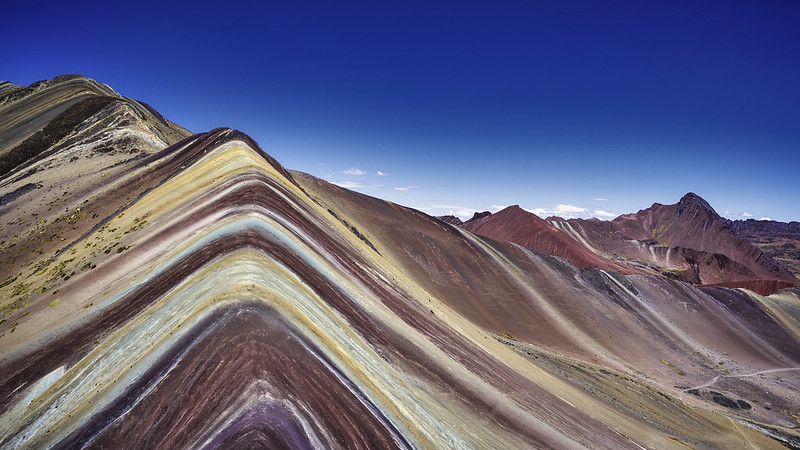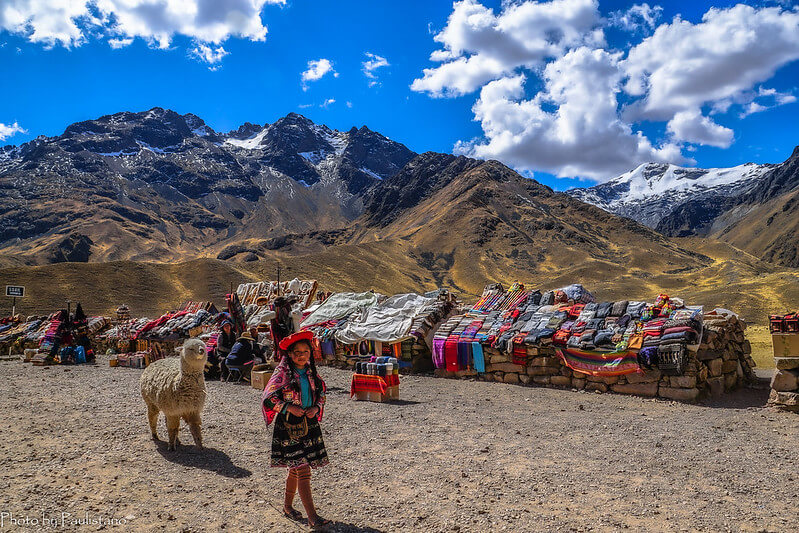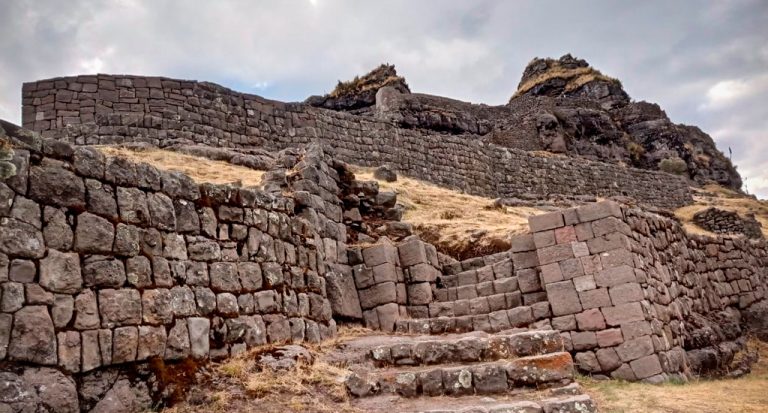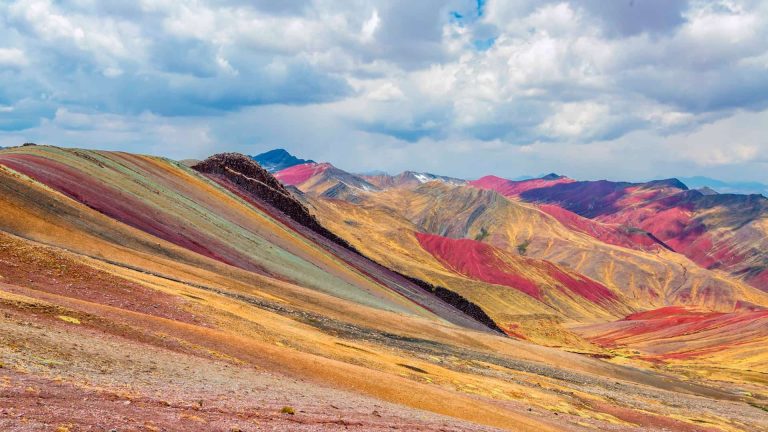ITINERARY
Day 1: Cusco– Pukutuni School – Pucaccocha
The Ausangate Trek to Machu Picchu from APPLE TRAVEL PERU will pick you up at 4 a.m. Then you’ll have a three-hour drive to the trailhead at Pukutuni School. Here you’ll enjoy some breakfast and meet your APPLE TRAVEL PERU team including the local chef, porters, and horsemen.
Then you’ll have a three-hour hike to your lunch spot at Upis village in the skirt of Ausangate Mountain. After you’ve enjoyed your freshly prepared lunch, you’ll hike for 1.5 hours uphill to the first pass called Vicuña Pass (4850 meters above sea level). We’ll break there for a bit to allow you to enjoy the views.
Then you’ll continue the last leg of Day 1 on the Rainbow Mountain trek with a 3-hour walk to your evening campsite at Pucaccocha. You’ll be able to enjoy breathtaking views along the way. You’ll see stunning views of the valleys, waterfalls, and glacier peaks.
Your APPLE TRAVEL PERU chef and porters will be waiting for you at your evening campsite. They’ll prepare food and get your tent set up so you can just relax and enjoy your surroundings.
- Trailhead elevation: 4200m
- Walking distance. 16km
- Campsite elevation. 4600m
- Weather: Cold
- Rate: Challenging
Day 2: Pucaccocha – Condor pass – Alpaca pass – Sororni Lake
After an early nutritious breakfast cooked by your Apple Travel chef, you’ll continue the Rainbow Mountain Trek with a 2-hour climb to Condor pass (4900 meters above sea level). On the way, you’ll have magical views of Ausangate mountain, and lagoons and perhaps even see some llamas and alpacas. It is then a gradual downhill hike for 2 hours to your lunch spot. After lunch, you’ll have a small climb to Alpaca pass (4950 m) where you can see a small part of Rainbow Mountain. After one more hour of downhill hiking, you’ll get to this evening’s campsite. Here your APPLE TRAVEL PERU team will take care of all the details while relaxing you and experiencing one of the most beautiful spots to take in the Andean sky.
- Walking distance: 08 km
- Campsite elevation: 4700m
- Weather: cold
- Rate: Challenging
Day 3: Soroni Lake – Rainbow Mountain – Kayrawiri – drive to Ollantaytambo and train to Aguas Calientes
Spending the night in the mountains means you’ll be one of the first to arrive at the stunning Rainbow Mountain. You’ll enjoy a pleasant breakfast with hot drinks served by your APPLE TRAVEL PERU team to start your morning. You’ll hike for 2 hours gradually uphill to get to this famous mountain.
On the way, you’ll have the chance to see some wildlife of vicuñas. Upon your arrival, the views will be stunning and because it’ll be so early you should be able to get some spectacular photographs without worrying about crowds. Your APPLE TRAVEL PERU guide will explain all the mountains’ different colors and minerals. Once you are ready to leave it’ll be 1 hour to the end of the trail. You’ll then say goodbye to your APPLE TRAVEL PERU trekking team and continue from this point with your Rainbow Mountain Trek guide.
It’ll be a 4-hour drive to Ollantaytambo where you’ll have some dinner before catching your 7 p.m. train to Aguas Calientes. Then you’ll have the opportunity to take a nice hot shower and sleep in a comfortable bed in a local hotel.
- Walking: 6 km
- Weather: Cold
- Rainbow mountain elevation: 5030m
- Rate: Challenging
Day 4: Machu Picchu & return to Cusco
Today is the day on the Rainbow Mountain tour that you’ll get to visit Machu Picchu. To get the most out of the day APPLE TRAVEL PERU encourages every one of our groups to start the day early. You can grab some breakfast before catching one of the first buses up to Machu Picchu (starting at 5:30 a.m.).
The hotel will hold your bags for you, allowing you to only have to bring your day pack with you. It’s a 30-minute bus ride from Aguas Calientes to Machu Picchu. Once you arrive at Machu Picchu your tour guide will introduce you to the world-famous Machu Picchu ruins.
The very first thing your guide will do is bring you the best place to watch the sunrise and get pictures. Once the sun rises, your tour guide will walk you around the main areas and explain the history for a 2.5-hour-long walking tour. After the guided tour of Inca history and culture, participants of the Rainbow Mountain Trek will have uninterrupted time to explore the ruins. Those who booked in advance for the Huayna Picchu hike can take advantage of this opportunity as well, though tickets cost $75 per person and sell out quickly. Then your guide will show you where to begin this hike which will take no more than 2 hours round-trip. In summary, the excursion offers an enriching experience for all.
For your return trip from Machu Picchu, we recommend beginning heading back to Aguas Calientes town no later than 2 hours before your train departure. Your guide will inform you of your train times before your return. After a 2-hour train ride from Aguas Calientes to Ollantaytambo, you will arrive at the train station’s exit door where the APPLE TRAVEL PERU staff will be waiting for you. From there, they will take you by car on a 2-hour journey back to Cusco. Along the way, you can enjoy the scenic views and relax before arriving at your destination You do have the choice to hike the Machu Picchu Mountain instead of Huayna Picchu Mountain. However, this hike is more challenging and takes three hours minimum, round-trip (at an extra cost of $75 per person).
Included
Professional Guides:
All of APPLE TRAVEL PERU’s guides on our Rainbow Mountain Trek studied English and tourism at Cusco National University. Additionally, they all grew up in the Cusco region and are committed to teaching others about their heritage. Not only are they fun, but they’re also professional and will ensure you are safe and happy on your Rainbow Mountain tour.
Briefing:
The night before your Lares Trek around Rainbow Mountain and Ausangate to Machu Picchu, you’ll come to APPLE TRAVEL PERU’s office at 6:30 p.m. for your briefing with your trekking guide. During this briefing, you’ll receive your APPLE TRAVEL PERU duffel bag for your items. This duffel bag must include your sleeping bag and air mattresses, which weigh 2.5 kg and 1 kg respectively. All duffel bags will be carried by your porters and will only be available at your campsite each day, both in the morning and in the evening. Therefore, any items that are needed while hiking should be packed in your daypack.
Porters & Horsemen:
As part of their service, APPLE TRAVEL PERU includes a personal porter who is responsible for carrying your duffel bag containing your items. This is provided to you at no additional fee. At your briefing the night before your trek, your duffel bag will be provided to you and you should fill it with your necessities for the next night and day. However, it’s important to note that you will not have access to your duffel bag until you arrive at your evening campsite.
Emergency Horse:
In addition, it’s worth noting that all of APPLE TRAVEL PERU’s alternative treks include an extra horse for our clients to use if they need a break from trekking
Transportation:
It’s important to note that all your transportation is included in this trek. Specifically, you’ll be picked up directly from your hotel around 4:30 a.m. and brought to the trailhead to begin your trek. Then, once you complete the trek, you’ll be brought back directly to your hotel in Cusco for drop-off.
Equipment:
Furthermore, it’s worth mentioning that APPLE TRAVEL PERU has the best equipment. Specifically, we use Eureka Timberline 4-person tents that are shared by only two people. This allows for more space and comfort during your trek. Additionally, you’ll have a spacious dining tent to enjoy your meals in.
Food:
Additionally, it’s worth noting that the chefs at APPLE TRAVEL PERU take great pride in their cooking and strive to create delicious meals for all trekkers. To ensure that all dietary restrictions are accommodated, it’s important to add them to the booking form and inform your guide during the briefing.
Throughout the trek, you can expect to be served breakfast, lunch, and dinner each day, all of which are typically served family style. In addition, a happy hour of tea and snacks will be provided, along with a morning snack to enjoy during the hike.
As your trek comes to a close, you will have one final meal with your chef after breakfast on day four. However, it’s important to note that lunch on the last day is not included, so you may want to plan accordingly.
Water:
Furthermore, APPLE TRAVEL PERU takes great care in ensuring that all trekkers have access to safe drinking water throughout the journey. From the first lunch to the last breakfast, the company will supply all the water needed, which is boiled, filtered, and cooled before distribution.
To make the most of this service, it’s recommended that you bring your personal water bottles or a camelback with a capacity of approximately 3L. You’ll be able to refill your water at each mealtime and at various points throughout the trek, ensuring that you stay hydrated and energized throughout your adventure.
First Aid:
Additionally, it’s important to note that every APPLE TRAVEL PERU guide has received training in first aid from a physician. To ensure that all of our guides are up-to-date with the latest medical knowledge and techniques, we conduct mandatory training sessions every February, which every APPLE tour guide must attend.
Moreover, your tour guide will always have a first-aid kit for basic medical situations, such as traveler’s diarrhea, cuts, scrapes, and so on, as well as oxygen. In the event of an emergency, we will act quickly to get you off the trail as quickly and comfortably as possible and ensure that you get directly to a clinic for treatment
Extras:
At APPLE TRAVEL PERU, we firmly believe that it’s the attention to small details that sets us apart from other tour companies. To ensure our trekkers have the very best vacation, we provide various amenities such as a small pillow for comfortable sleep, a foam mattress for insulation, a day pack cover to protect their belongings while hiking, and a rain poncho. We work tirelessly to guarantee that every aspect of your trip is taken care of
Satellite Phones:
At APPLE TRAVEL PERU, the safety of our clients and team is our top priority. Although our guides are prepared and trained to deal with any issues that may arise during the trek, we understand the importance of having access to medical assistance or reaching out to loved ones in case of an emergency. To ensure this, we have equipped every guide with a satellite phone that can be used anywhere on the mountain to reach us, regardless of how far the radios can reach. Additionally, clients can also use the satellite phone for non-emergencies or to check in with their loved ones at home. While the use of satellite phones is not cheap, we believe it’s a necessary investment to guarantee the safety and peace of mind of our clients
Not Included
- Rentals: Every trekker needs a sleeping bag when camping. Inflatable air mattresses and walking sticks (with rubber tips) are optional but encouraged. If you don’t want to bring any of the above, they are all available for rent: Sleeping Bag: $20
- Inflatable Air Mattress: $15
- Walking Sticks (Pair): $15
Price
- $650 per person
Student Discount:
- $25 off per person
Student discounts apply to anyone who has a valid UNIVERSITY STUDENT CARD at the time of the trek or who is 17 years old or younger. For those using a university student card to receive the discount, we need to see a copy of the card at booking. For those booking children 17 years old or younger, we need a copy of their passport at booking time. Please send all to appletravelperu@gmail.com
More Information about STUDENT CARD
Rentals:
Sleeping Bag (four seasons): $20 (Maximum size 1.95m / 6’4″)
Pair of walking poles (Black Diamond): $15
Inflatable air mattress (Thermarest): $15
* Foam mats and small pillows are provided for everyone.
Getting to Cusco for the Ausangate Trek to Machu Picchu 4 days
The airport in Cusco currently is only for domestic flights. Therefore, all international travelers by plane must disembark in Lima and go through Customs. Even if your flight to Cusco is the same day by the same airline carrier, you must grab your bags in Lima and then check them back in.
The best way to get to Cusco is by air and there are several options on airlines. LAN tends to be the most expensive but has the most options and flights. Expect delays or flight cancellations. Due to the high altitude of Cusco, it tends to be difficult to land and any acclimate weather will stop air traffic. Bus travel is always available and while the trip can be long, especially from Lima the buses in Peru are very well-maintained and comfortable. This option is strongly encouraged if coming from a city closer to Cusco like Puno. Lima buses will take about 20 hours to arrive.
Luggage Storage:
Any extra luggage you have with you can be left safely in Cusco at either your hotel or with us at the APPLE TRAVEL PERU office while you trek. We’ll store your luggage on the morning of your trek and return it once you’re back in Cusco. Make sure your bags have tags on them so they are easy to locate.
Altitude
As soon as people book their trip to Peru, specifically Cusco they start wondering about altitude sickness. The air at high altitudes contains less oxygen than at sea level and forces your body to work harder to get the oxygen it needs. Over several days at high altitudes, your body adjusts to the lower amount of oxygen in the air. For this reason, we always recommend spending at least two days in Cusco before beginning any trek in the Andes. Cusco is a marvelous city with lots to do so if you have more time to acclimate you won´t be bored.
With altitude sickness, you may first feel like you have the flu or a hangover. You may have a headache, tiredness, loss of appetite, nausea, vomiting, dizziness, trouble sleeping, or trouble breathing during exercise. If any of these effects become severe please contact our office and we’ll help you get to a doctor.
Preventing Altitude Sickness: Tips for Easing Into High Altitude Activities
Most of the time these symptoms will be mild. We always recommend easing into the activity slowly allowing your body time to adjust. Drink plenty of fluids such as water or coca tea. Coca-tea has been used since ancient times to help prevent altitude sickness. Leaves from the Coca Plant contain alkaloids that help bring oxygen into your blood. This helps your body avoid the effects of altitude sickness. Avoid drinking a lot of alcohol and coffee since they will cause you to urinate more often and become dehydrated. Avoid smoking. Smoking makes it more difficult for your body to get oxygen. Avoid sleeping pills. They may cause shallow breathing at night, making it more difficult for your body to absorb oxygen while you sleep.
Remember the trek to Machu Picchu is not a race. Even those in the best shape will suffer from altitude sickness if they race to the top of the mountain too quickly. Go slow and it’ll give your body time to adjust to the elevation. Your healthcare provider may prescribe medication such as Acetazolamide and Dexamethasone to help prevent altitude sickness. Start the medicine two days before you get to a high altitude and continue to take it while you are at a high altitude. You must remember that this is your holiday and you don’t want to stress out about the possibility of getting sick from it. Do everything slowly, drink lots of water, and enjoy the coca tea. If anything happens and you, unfortunately, get sick, let your guide know immediately. APPLE TRAVEL PERU guides are trained to help you get through it.
Weather
Of course, the weather is unpredictable. The Cusco dry season is from April to October. Although this does not stop rain from falling in June or the sun from coming out in December so just be prepared. No matter what month you are doing the trek make sure that you have rain gear that includes a waterproof jacket, pants, poncho, and waterproof gloves. Many people forget about gloves but being cold and wet makes hiking unpleasant.
Also, be ready for four seasons. Treks in the Andes involve various microclimates and you will need to be prepared for each one. Layers are always vital since they easily adjust to different temperature changes. Be prepared with a warm packable down jacket since the evening will be cold.
First Aid
Every APPLE TRAVEL PERU guide has received training in first aid from a physician. We conduct mandatory training every February and every APPLE guide attends. When guiding you they’ll have with them a first aid kit for basic medical situations (traveler’s diarrhea, cuts, scrapes, etc.) and oxygen.
In case something unexpected happens and you feel you can no longer complete the trek they’ll figure out the safest and quickest way off the trail and to a clinic. You’ll never be left alone, you’ll have a member of the team escort you every step of the way until you are safe with a doctor. When you’re feeling up to it, we’ll make sure that you still have the chance to visit Machu Picchu and reconnect with your group. This way you can finish your trip traveling by train comfortably.
Travel Insurance
To protect your travel investment, we highly recommend the purchase of travel insurance. Getting travel insurance before you leave home is strongly encouraged and very easy. We work with a great agency in the United States that has helped to make it easy and affordable. It’s an excellent way to protect yourself while you are visiting Peru.
Environmental Impact
APPLE TRAVEL PERU uses biodegradable soap and transports all our garbage back to Cusco. Our porters are trained to look after the trail and pick up any waste from other groups, as well. We also use environmentally-friendly chemical portable toilets that allow us to pack waste out. We strongly believe in leaving no footprint behind.
Community
APPLE TRAVEL PERU is proud of the work we do for our community as this is the main focus of our company. We’ve worked with villages directly to help supply them with the needs their families were missing. We’ve supported local schools by giving them computers and books. Apple Travel Peru also sponsors a teacher in the village. This is where most of our porters come from and ensures their children have the best opportunity for education.
We buy all our food from local farmers and markets and serve the freshest ingredients. We provide English classes for all our team including guides, porters, chefs, and drivers. We’re also building a house for our porters. By giving them a safe and comfortable place to stay before and after our treks.
Twice every year we bring our porters and their families to Machu Picchu. The men and women who work tirelessly have never visited the Lost Citadel of the Incas. So that makes this trip our favorite to do. It’s an honor to show them this place.
Personal Porter Included
All APPLE TRAVEL PERU camping treks include porters who’re responsible for carrying and setting up all equipment. They’ll additionally carry the duffel bag you receive at your briefing the night before your trek. Each duffel bag cannot exceed 7kg/14lbs and must include your sleeping bag and air mat. APPLE TRAVEL PERU gives each porter a proper uniform, salary, and insurance. They’re the backbone of our company.
Packing list for Ausangate Trek to Machu Picchu 4 days
- Day pack
- Copy of your passport
- Good hiking gear: hiking boots, warm jackets, gloves, hat, warm fleece, and socks
- Sleeping bag
- Walking boots
- Waterproof jacket/rain poncho
- Hat and gloves
- Warm clothes: Layers for variable temperatures, especially at night
- T-shirts
- Comfortable trousers
- Sun hat
- Sunscreen
- Insect repellent
- Reusable plastic/metal water bottles, or camel bags
- Water for the first four hours of the trek, then we’ll provide you with drinking water
- Toiletries
- Personal medication
- Camera and films
- Flashlight with spare batteries
- Walking stick
- Bathing suit for the hot springs
- Extra money for souvenirs, drinks, and tips










